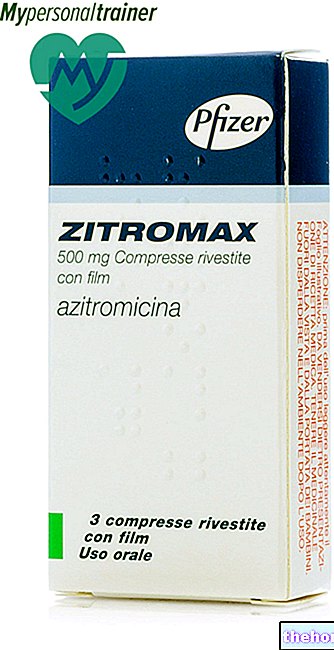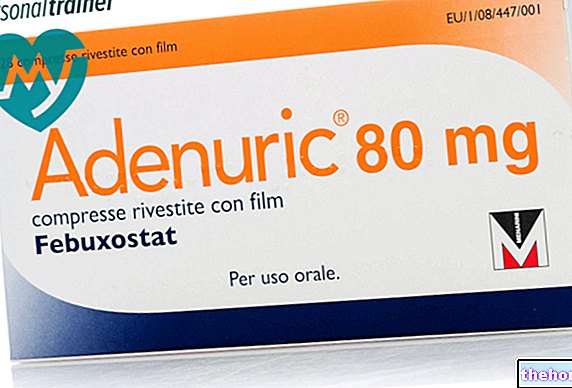Active ingredients: Xylometazoline (xylometazoline hydrochloride)
ACTIGRIP NASAL 1 mg / ml Nasal spray, solution
Why is Actigrip Nasale used? What is it for?
NASAL ACTIGRIP contains xylometazoline, a substance that helps constrict the blood vessels of the nose, reducing edema of the nasal mucosa (the inner lining of the nose), and facilitating breathing. ACTIGRIP NASALE also contains hyaluronic acid (in the form of sodium hyaluronate) , which protects and moisturizes the nasal mucosa.
The spray is used for the short-term treatment of nasal congestion with runny nose due to the common cold or sinusitis.
Contraindications When Actigrip Nasal should not be used
Do not use ACTIGRIP NASALE in the following cases:
- allergy to xylometazoline or any of the other ingredients of this medicine (listed in section 6)
- elevated eye pressure, especially in the presence of narrow-angle glaucoma
- chronic rhinitis (long-lasting nasal irritation) with little or no discharge (dry rhinitis)
- you are being treated with monoamine oxidase inhibitors (MAOIs) or taking MAO inhibitors within the previous 2 weeks
- you are taking other medicines that can increase your blood pressure
- you have an "inflammation caused by hypersensitivity of the blood vessels in the nose
- there is an "inflammation associated with thinning of the nasal membranes with or without secretion
- have recently undergone nasal or oral brain surgery.
This spray should not be used in children under 12 years of age.
Precautions for use What you need to know before taking Actigrip Nasale
Talk to your doctor or pharmacist before using this spray in the following cases:
- marked reaction to sympathomimetic agents (adrenaline-like products), as the use of ACTIGRIP NASAL may cause insomnia, dizziness, tremor or uncontrollable spasms, irregular heartbeat or abnormal heart rhythm or increase in blood pressure.
- heart problems, vascular problems, hypertension
- overactive thyroid gland, diabetes or other metabolic problems
- pathologies of the adrenal glands
- enlarged prostate (prostatic hypertrophy).
Continued use of the product for long periods can lead to worsening of congestive symptoms.
Interactions Which drugs or foods can modify the effect of Actigrip Nasale
Check with your doctor or pharmacist before using Nasal Actigrip.
Do not use the spray if you are taking:
- some antidepressant medications, such as tricyclic or tetracyclic antidepressants or MAOIs or if you have been taking MAOIs within the last 2 weeks (see "Do not use" section)
- other medicines that can increase blood pressure.
Tell your doctor or pharmacist if you are taking or have recently taken any other medicines, including medicines obtained without a prescription.
Warnings It is important to know that:
Pregnancy and breastfeeding
If you are pregnant, think you may be pregnant or are planning to become pregnant, ask your doctor or pharmacist for advice before using this medicine.ACTIGRIP NASAL should not be used during pregnancy as its action on the fetus is not fully known.
While breastfeeding, consult your doctor before using this medicine. It is not known whether the active substance is transferred into breast milk.
Driving and using machines
ACTIGRIP NASALE has no known effects on the ability to drive or use machines.
Dose, Method and Time of Administration How to use Actigrip Nasale: Posology
Adults and children over 12 years old.
Unless otherwise directed by your doctor or pharmacist, a "delivery of
NASAL ACTIGRIP in each nostril up to 3 times a day for up to 7 days.
- Remove the protective cap. Activate the bottle before use by pressing several times until a homogeneous spray of the solution comes out (see Figure 1). The inhaler is now ready for use.
- Hold the inhaler upright. Insert the nozzle into the nostril - do not spray out of the nose (see Figure 2).
- Press once. Breathe vigorously through the nose at the time of vaporization. Repeat the operation in the other nostril.
- After use, put the cap back on the bottle.
To reduce the risk of infections, the bottle should not be used by more than one person and the spout should be cleaned after each use.
DO NOT use this spray on children under 12 years of age.
Overdose What to do if you have taken too much Actigrip Nasale
If you use ACTIGRIP NASALE more than you should
Contact your doctor, pharmacist or the nearest emergency room immediately, taking the medicine or its package leaflet with you.
If you forget to use ACTIGRIP NASALE
If you miss a dose, take it as soon as possible, but if it is near the time for your next dose, skip the missed dose and continue as normal. Do not take a double dose to make up for a forgotten dose.
If you have any further questions on the use of this medicine, ask your doctor or pharmacist.
Side Effects What are the side effects of Actigrip Nasale
Like all medicines, NASAL ACTIGRIP can cause side effects, although not everybody gets them.
Stop using the nasal spray and seek immediate medical attention if any of the following symptoms appear which could indicate an allergic reaction:
- difficulty breathing or swallowing, swelling of the face, lips, tongue or throat
- severe itching of the skin, with red rash or bumps
Other side effects include:
Common (may affect up to 1 in 10 people):
- tingling or burning sensation in the nose and throat and dryness of the inner lining of the nose (nasal mucosa).
Rare (may affect up to 1 in 1,000 people):
- headache, increased blood pressure, nervousness, feeling sick, dizziness, insomnia and palpitations
- systemic allergic reactions and temporary changes in vision.
Not known (frequency cannot be estimated from the available data):
- worsening of symptoms of nasal congestion after stopping use of the product.
If you get any side effects, talk to your doctor or pharmacist. This includes any possible side effects not listed in this leaflet.
Expiry and Retention
Keep out of the reach and sight of children.
Do not store above 25 ° C.
Once the package is opened, DO NOT use NASAL ACTIGRIP for more than 12 months.
Do not use ACTIGRIP NASALE after the expiry date stated on the package.
Do not dispose of any medicines via wastewater or household waste. Ask your pharmacist how to throw away medicines you no longer use. This will help protect the environment.
Composition and pharmaceutical form
What ACTIGRIP NASALE contains
The active ingredient is xylometazoline hydrochloride, in the amount of 1 mg per milliliter of solution. Each spray-dose of NASAL ACTIGRIP (= 140 μl) contains 140 μg of xylometazoline hydrochloride.
The other ingredients are: sodium hyaluronate, sorbitol (E420), glycerol (E422), sodium dihydrogen phosphate dihydrate, disodium phosphate dihydrate, sodium chloride and water for injections.
What ACTIGRIP NASALE looks like and contents of the pack
The spray is a clear, colorless or slightly yellowish solution contained in a 10 ml white plastic bottle with a dosing pump.
Source Package Leaflet: AIFA (Italian Medicines Agency). Content published in January 2016. The information present may not be up-to-date.
To have access to the most up-to-date version, it is advisable to access the AIFA (Italian Medicines Agency) website. Disclaimer and useful information.
01.0 NAME OF THE MEDICINAL PRODUCT
ACTIGRIP NASALE 1 MG / ML NASAL SPRAY, SOLUTION
02.0 QUALITATIVE AND QUANTITATIVE COMPOSITION
Xylometazoline hydrochloride 1 mg in 1 ml of solution
Each spray-dose (140mcl) contains 140mcg of xylometazoline hydrochloride
For the full list of excipients, see section 6.1.
03.0 PHARMACEUTICAL FORM
Nasal spray, solution.
Clear, colorless or slightly yellowish solution.
04.0 CLINICAL INFORMATION
04.1 Therapeutic indications
Temporary symptomatic treatment of nasal congestion due to rhinitis or sinusitis.
04.2 Posology and method of administration
For nasal use.
Adults and children over 12 years:
One puff into each nostril no more than three times a day. This medicine should be used for a maximum of 7 days, unless otherwise prescribed.
To minimize the risk of infections, the product should not be used by more than one person and the spout should be cleaned after each use
Children
ACTIGRIP NASALE is contraindicated in children under 12 years (see section 4.3).
Senior citizens
Same dosage as adults.
04.3 Contraindications
ACTIGRIP NASALE should not be used:
• in patients with hypersensitivity to the active substance or to any of the excipients listed in section 6.1
• in patients with high intraocular pressure, particularly in the presence of narrow angle glaucoma
• in patients with "dry" inflammation of the nasal mucosa (Dry rhinitis)
• in children under 12 years of age
• after transphenoidal hypophysectomy or other transnasal / transoral surgery with exposure of the dura mater
• in patients taking monoamine oxidase inhibitors (MAOIs) or who have used these drugs in the previous 2 weeks, or in patients taking other medicinal products with potential for hypertensive effect
• in patients with atrophic or vasomotor rhinitis
04.4 Special warnings and appropriate precautions for use
Xylometazoline, like other medicinal products belonging to the same pharmacological category, should be administered with caution in patients with marked reaction to sympathomimetic substances. The use of substances of this type can cause a variety of disturbances in these patients, such as insomnia, dizziness, tremors, arrhythmia or elevated blood pressure.
Particular caution is required in the case of patients suffering from cardiovascular disease, hypertension, hyperthyroidism or diabetes, as well as in the case of patients with prostatic hypertrophy and pheochromocytoma.
In case of prolonged treatment with xylometazoline, with the suspension of therapy sometimes the reappearance of the symptoms of rhinitis and mucous membrane edema is observed. In these cases, it may also be the so-called "rebound" phenomenon caused by the drug itself, which progresses to chronic edema and atrophy of the nasal mucosa (Medicamentous rhinitis and dry rhinitis). To avoid this, the duration of treatment should be as short as possible (see section 4.2). Nasal and paranasal inflammations of bacterial origin must be treated appropriately. For the treatment of allergic rhinitis, this product can only be used temporarily as a supportive therapy.
04.5 Interactions with other medicinal products and other forms of interaction
The use of the product is not recommended concomitantly with tricyclic or tetracyclic antidepressant drugs or monoamine oxidase inhibitor drugs (MAOIs), or in the two weeks following the use of MAO inhibitors.
04.6 Pregnancy and lactation
There are no data regarding the trans-placental passage of xylometazoline, nor its secretion in breast milk. Due to the potential systemic vascular constricting effect, this medicinal product should not be used in pregnancy. During lactation this medicine should be used with caution as it is not known whether or not the active substance is transferred into breast milk.
04.7 Effects on ability to drive and use machines
When used correctly, xylometazoline does not appear to have any influence on the ability to drive or use machines.
04.8 Undesirable effects
The most frequently reported side effects of this medicine are tingling or burning of the nose and throat and dryness of the nasal mucosa.
Based on their frequency, side effects were divided into the following categories:
Very common ≥ 1/10
Common ≥ 1/100 to
Uncommon ≥ 1/1000 to
Rare ≥ 1 / 10,000 y
Very rare
Not known frequency cannot be estimated from the available data
04.9 Overdose
Being an "imidazoline, systemic xylometazoline overdose can cause a wide range of symptoms related to cardiac and nervous system stimulation or depression.
Cases of overdose are mainly related to the use of the drug in children. Symptoms of intoxication reported include severe paralysis of the central nervous system, sedation, dry mouth and perspiration, as well as symptoms caused by stimulation of the sympathetic nervous system (tachycardia, pulse irregular and elevated blood pressure.) One drop (single dose) of the xylometazoline preparation for adult use (1 mg / ml) administered intranasally caused a 4-hour coma in a 15-day-old infant. up, the newborn is completely healed.
Treatment of intoxication is nosotropic and may include administration of charcoal, gastric lavage, and inhalation of oxygen. 5 mg of phentolamine in saline intravenously or 100 mg orally are administered slowly to reduce blood pressure. administered antipyretics and anticonvulsants. The use of vasopressor substances is contraindicated.
05.0 PHARMACOLOGICAL PROPERTIES
05.1 Pharmacodynamic properties
Pharmacotherapeutic group: Preparations for nasal use, Sympathomimetics, unassociated ATC code: R01AA07.
Xylometazoline is a derivative of imidazole which produces a sympathomimetic effect. Xylometazoline nebulized on the nasal mucosa immediately induces a lasting constriction of the blood vessels of the nose with consequent reduction of the obstruction of the nasal cavity.
This effect can be produced through direct stimulation of postsynaptic alpha receptors. Xylometazoline has no effect on beta-adrenergic receptors.
In the treatment of allergic rhinitis, xylometazoline nebulized in the nose is indicated only for temporary use or to facilitate the administration of other medicinal products with a topical effect on the nasal mucosa.
Symptoms of rebound (edema of the lining of the nose and nasal obstruction) that sometimes accompany long-term use may be caused by the drug's effect of stimulating alpha2 presynaptic receptors and reducing noradrenaline release. With vasoconstrictor drugs, rebound symptoms usually appear after 2-3 weeks of continued treatment, but during the tests xylometazoline was administered to healthy subjects for up to 6 weeks without any mucosal swelling or tachyphylaxis.
In vitro, xylometazoline was found to compromise the functionality of chenocilia, but this effect is not permanent.
ACTIGRIP NASALE contains, among other things, hyaluronic acid (in the form of sodium hyaluronate), which produces a moisturizing effect on the mucous membranes of the nose.
05.2 Pharmacokinetic properties
In topical use, the vasoconstriction effect usually occurs within 5-10 minutes of drug administration. The nasal obstruction reducing effect lasts about 6-8 hours. If the product is used and dosed correctly, its passage into the systemic circulation is absolutely negligible. However, in case of high dosage and if ingested, absorption of the product and consequent systemic effects may occur. There are few data available regarding the distribution, metabolism or secretion of xylometazoline in the human body.
05.3 Preclinical safety data
Lack of essential clinical safety data.
06.0 PHARMACEUTICAL INFORMATION
06.1 Excipients
Sodium hyaluronate
Sorbitol (E420)
Glycerol (E422)
Sodium dihydrogen phosphate dihydrate
Disodium phosphate dihydrate
Sodium chloride
Water for injections
06.2 Incompatibility
Not applicable.
06.3 Period of validity
2 years.
Once opened, ACTIGRIP NASALE should not be used for more than 12 months.
Do not use after the expiry date indicated on the package.
06.4 Special precautions for storage
Do not store above 25 ° C.
06.5 Nature of the immediate packaging and contents of the package
White HDPE bottle, with 3K pump system, plastic liner, carton box.
10 ml nasal spray.
06.6 Instructions for use and handling
No special instructions
07.0 MARKETING AUTHORIZATION HOLDER
Johnson & Johnson S.p.A. Via Ardeatina Km 23,500-00040 Santa Palomba Pomezia (Rome)
08.0 MARKETING AUTHORIZATION NUMBER
AIC 040282016 "1 mg / ml nasal spray, solution" 1 HDPE bottle of 10 ml
09.0 DATE OF FIRST AUTHORIZATION OR RENEWAL OF THE AUTHORIZATION
APRIL 16 2012
10.0 DATE OF REVISION OF THE TEXT
March 2015




























